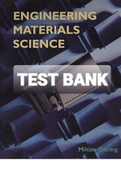Exam (elaborations)
TEST BANK FOR Engineering Materials Science By Milton Ohring (Solution Manual)
- Course
- Institution
Exam (elaborations) TEST BANK FOR Engineering Materials Science By Milton Ohring (Solution Manual) Exam (elaborations) TEST BANK FOR Engineering Materials Science By Milton Ohring (Solution Manual) SOLUTIONS TO PROBLEMS PREFACE This section of instructors materials contains solutions and answers ...
[Show more]



